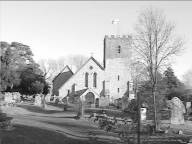![]()

![]()
24. All Saints Catherington

This church is best approached from the western entrance via the attractive lych gate built as a memorial to the men of the parish killed in the First World War. Walk through the pathless churchyard towards the twelfth century Norman church with its steep nave roof and massive South West tower. The latter has a Norman base, but a red brick battlemented upper storey was added in 1750 to take a peal of five bells. The flag of St George flutters gaily overhead.
Entering the red tiled nave look up to see the magnificent fourteenth century timbered roof with its massive tie beams extending the whole length of the church. The rounded Norman pillars and rounded arches run right down the nave, some with simple scalloped capitals and others with moulded octagonal designs. Immediately facing you on the north wall alongside the organ pipes, is a well preserved fourteenth century wall painting. This depicts St Michael weighing souls. He stands holding an upright sword. The Devil is seen at one end of the scales trying to pull down souls to eternal damnation, whilst the Virgin Mary on the left side is trying to prevent them from being weighed down. Altogether a striking medieval picture.
The stained glass in the aisle windows and above the 13th century West door is largely Victorian and not particularly memorable. Likewise the East Window dates from the 1885 restoration. The plain glass at the base ensures that the chancel is well lit. To the left of the altar is a Latin memorial commemorating John Williams L.L.D. who died in 1778 having been vicar for 38 years.
On the north side of the chancel is the impressive Hyde Chapel which is dominated by the large canopied tomb of Sir Nicholas Hyde and his wife dating from 1631. On either side columns of marble support the figures of Justice and Wisdom with the Hyde Coat of Arms in the centre. Sir Nicholas lies alongside his wife clad in the scarlet robes befitting a Chief Justice of the Kings Bench. Their ten children are depicted on the front of the tomb. High above is an attractive small circular window with red flower like paintings in the inset and two small lancet windows alongside.
Many nineteenth century memorials can be seen in this chapel such as that of John Todd who 'died of a wound he accidentally received when shooting' in September 1809. A more interesting epitaph is that of a Captain Charles Napier R.N. who 'after a short but honourable career was suddenly cut off at the age of 35 years whilst in command of H.M. steam frigate Avenger wrecked near the coast of Tunis on the 20 December 1847.'
The South Transept, added in 1883 as a choir vestry, contains a copy of Titian's painting 'Descent From the Cross.'
Before leaving stroll around the large churchyard which contains some interesting tombstones. Beyond the east end of the church is the tomb of the family of Edmund Kean the great Shakespearian actor, including his daughter-in-law Ellen Tree a noted actress of the mid-Victorian era. Not far away is the tomb of Admiral Sir Charles Napier 1786-1860, known as Black Charlie. He became involved in a revolution in Portugal in 1830, was as a consequence dismissed from the Navy but later re-instated and commanded the Baltic Fleet in the Crimean War.
Finally when walking back to the lych gate look at the large Cross. This was built as a memorial to Rear Admiral Sir Christopher Cradock gallantly killed in action on November 1 1914 at the Battle of Coronel off the coast of Chile, leading his squadron against vastly superior German forces commanded by Admiral von Spee. Only five weeks later this defeat was avenged by Admiral Sturdee at the Battle of the Falkland Islands.
written by John Symonds
![]() Return to the Christmas & New Year 1998/99 Features
page
Return to the Christmas & New Year 1998/99 Features
page
![]() return to Home page and main index
return to Home page and main index
page last updated 6 DECEMBER 1998